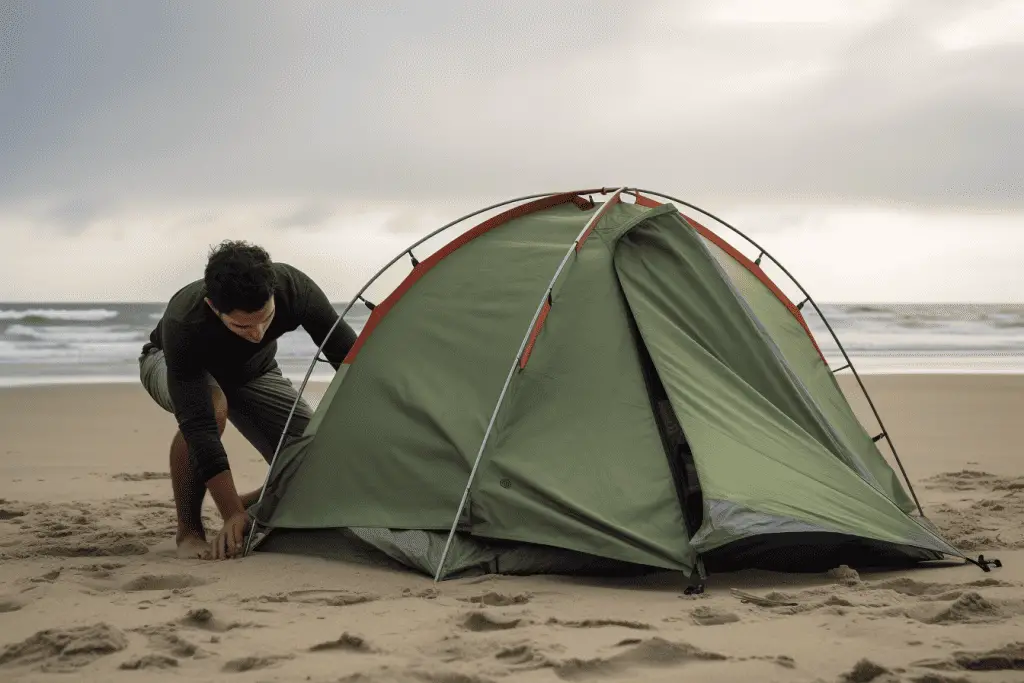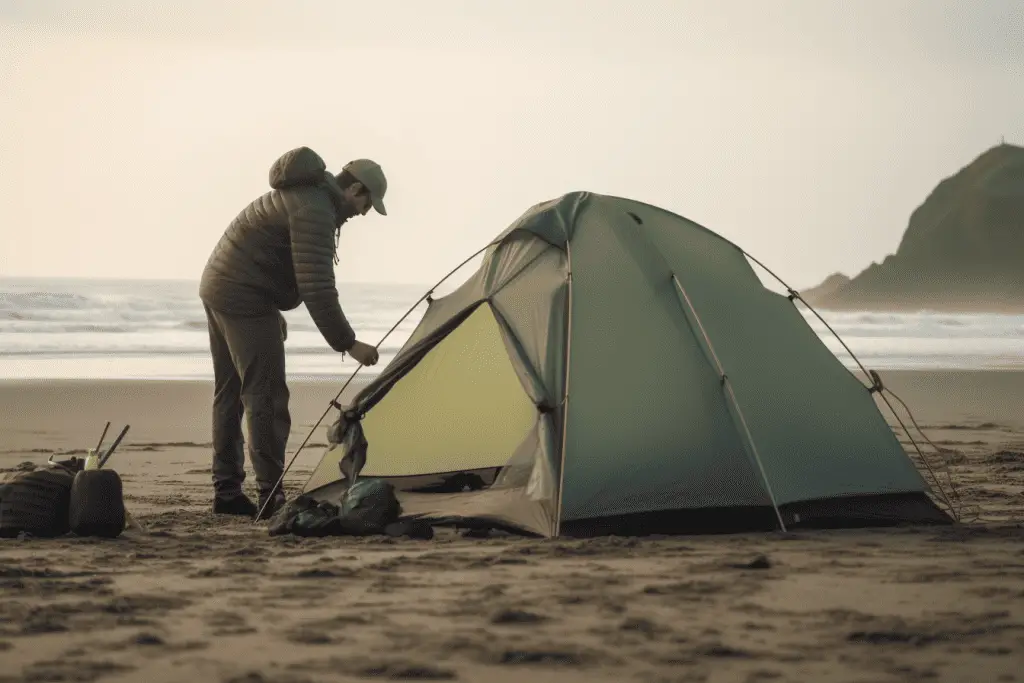Need to know how to stake a tent in sand? Whether you’re camping at the beach or in the desert, here are 10 steps you can use to get your tent staked out.
- Choose the Right Spot: The first step is to find an appropriate location to set up your tent. You’ll want a flat area, preferably above the high-tide line to prevent unexpected flooding. Also, be sure to check for signs of wildlife and avoid areas with too much debris or trash.
- Gather Your Gear: You’ll need a tent, sand stakes (also known as snow stakes), a mallet or hammer, a tent footprint or tarp if you have one, and possibly weight bags or sand anchors. Your gear should be specially designed for sand camping—regular tent stakes might not hold in loose sand.
- Lay Down Your Tent Footprint or Tarp: This optional step can provide additional protection for your tent, making it more comfortable to sleep in and keeping it cleaner. Make sure it’s aligned with where you want to set up your tent.
- Set Up Your Tent: Assemble your tent according to the manufacturer’s instructions. Place it on top of your footprint or tarp, if you’re using one, ensuring it’s in the right position before you start staking. This might be a two-person job if it’s windy.
- Insert Your Stakes: Hold your stake at a 45-degree angle, pointing away from the tent. This angle helps to provide the best hold in loose sand. Push the stake as far as you can into the sand by hand.
- Secure Your Stakes: Use your mallet or hammer to drive the stakes the rest of the way into the sand until just the top of the stake is visible. Be careful not to hit them too hard—you don’t want to bend the stakes.
- Tie Your Tent to the Stakes: Attach your tent’s guy lines to the stakes. Guy lines are the cords that come out from the sides of the tent. Be sure to leave a little slack so the wind can move the tent slightly without pulling out the stakes.
- Create Deadman Anchors (Optional): If the sand is very loose or it’s particularly windy, you might want to create additional anchors. You can do this by filling a bag (a dedicated sand anchor bag or even a regular cloth bag) with sand and tying your tent’s guy lines to it. These “deadman” anchors can be buried in the sand for extra holding power.
- Double-Check Everything: Once your tent is staked and secure, give it a once-over. Make sure all stakes are firmly in the sand and all guy lines are properly attached. Check that the tent material isn’t too taut, which could cause it to tear in strong wind.
- Settle In: Now that your tent is secure, you can start moving your gear inside. Keep heavy items like backpacks towards the bottom of the tent to help weigh it down.
Navigating the Sand: The Unique Challenges of Camping on Sand
Setting up camp on a sandy beach can be an alluring prospect. Who wouldn’t love waking up to the sound of waves or watching the sunset over the ocean from their tent door? However, as any seasoned camper can tell you, staking a tent in the sand can present its unique set of challenges. This is where learning how to stake a tent in sand effectively can significantly enhance your camping experience.
Firstly, sand is not like the typical firm ground you’d find at your average campsite. It’s loose and shifts easily, which can cause regular tent stakes to lose their grip and pull out. This becomes particularly problematic when you’re dealing with coastal winds, which can really test the stability of your tent. Knowing how to stake a tent in sand properly will keep you prepared for these potential hiccups.

Secondly, you also need to consider the tide. If you pitch your tent too close to the water, you might find your tent—and yourself—getting an unexpected midnight bath! It’s essential to set up camp beyond the high-tide line to stay dry. Incorporating this knowledge into your strategy on how to stake a tent in sand will help you avoid any unexpected late-night surprises.
Lastly, sand can be surprisingly abrasive. If it gets into your tent, it can quickly wear down your gear. From sand in your sleeping bags to potential damage to your tent floor, beach camping can be a bit tough on your equipment if you’re not careful.
Picking Your Pegs: A Guide to Choosing the Best Sand Stakes
So, you’re gearing up for some beach camping and realize your usual tent stakes just aren’t going to cut it in the sand. Well, you’re on the right track! Choosing the right sand stakes can make a big difference in keeping your tent secure. But how do you know which ones are the best for your needs? Part of understanding how to stake a tent in sand is choosing the right tools for the job.
Sand stakes, sometimes called snow stakes, are specifically designed to grip in loose, granular surfaces. They’re generally longer, wider, and have a different shape than regular tent stakes, all to maximize their holding power in sand. Some even feature a corkscrew design to further enhance their grip. By selecting the right stakes, you’re one step closer to mastering how to stake a tent in sand.
When picking your sand stakes, there are a few things to consider. First, look at the material. Sand stakes need to be strong and durable, so materials like high-strength plastic, aluminum, or steel are good choices. Avoid anything that seems flimsy or that could easily bend or break.

Next, consider the length and width of the stake. Longer and wider stakes will hold better in sand. However, there’s a balance to strike. You don’t want them to be so large that they’re difficult to pack or carry. By taking into account all these factors, you’ll be well-equipped in your understanding of how to stake a tent in sand.
Finally, take a look at the design. Some stakes have additional features like holes or notches, designed to catch the sand and improve their grip. Others might have a brightly colored top or a reflective pull cord, which makes them easier to spot and remove.
Remember, the best sand stakes for you will depend on your specific needs, including the type of tent you have and the conditions you’re expecting. So do your research, read reviews, and choose the ones that fit your beach camping adventure best.
Tackling Tent Troubles in the Sand
Tent camping in the sand isn’t always easy and problems can arise. Take a look at the common issues below for solutions on what to do when your tent is giving you trouble in the sand.
- Problem: Tent stakes keep pulling out of the sand.
- Solution: Swap your regular tent stakes for sand stakes, which are designed to grip better in loose surfaces. You could also try creating “deadman” anchors by filling bags with sand and burying them, then attaching your guy lines to those.
- Problem: Wind is causing the tent to flap or even lift.
- Solution: Make sure your tent is oriented correctly, with the narrowest side facing the prevailing wind. Also, ensure all guy lines are properly secured, and consider adding additional weight inside the tent to help hold it down.
- Problem: The tent is sagging or collapsing.
- Solution: Ensure your tent poles are properly assembled and that the tent material is taut but not overly tight. Adjust the tension on your guy lines as needed.
- Problem: Sand is getting inside the tent.
- Solution: Close all doors and windows to limit sand blowing in. Also, consider using a vestibule or an extra tarp to create a ‘sand-free’ zone where you can clean off before entering the tent.
- Problem: The tent gets uncomfortably hot in the sun.
- Solution: Seek out natural shade if possible when setting up your campsite. If that’s not an option, consider using a sunshade or reflective blanket to create some shade for your tent.
- Problem: The high tide comes too close to your tent.
- Solution: Always set up camp beyond the high-tide line. If you’re unsure where that is, look for signs of previous high tides, such as driftwood or a change in the sand’s color or texture. Local knowledge can be invaluable too, so ask around if you can.
Remember, camping on the beach can present unique challenges, but with a bit of planning and problem-solving, you can secure your tent and enjoy a fantastic sandy adventure!
Wrapping Up: Embrace the Adventure of Sand Camping
And there you have it! While figuring out how to stake a tent in the sand might initially seem like a daunting task, with the right tools and techniques, it’s a challenge you can absolutely conquer. Just like any outdoor endeavor, preparation is key. Knowing what to expect and how to tackle potential issues can make all the difference.
Choosing the right gear—like sand stakes, a sturdy tent, and possibly a footprint or tarp—will set you up for success. Understanding the unique challenges of sand camping, like shifting grounds and coastal winds, will help you face any obstacle with confidence. And having a backup plan, should your tent not stay put, means you’re ready to troubleshoot on the go.
But above all, remember to enjoy the experience. Yes, beach camping can be a bit more demanding than pitching your tent on firm ground. But the reward? Waking up to the sound of the waves, enjoying the sunset right from your tent door, and experiencing the beach in a way few people do. That makes all the planning and adapting totally worth it.
